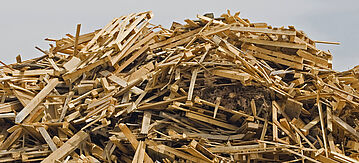Waste wood

In Germany, used wood in commercial municipal waste, for example from the wood treatment and processing industry – residual industrial wood, construction and demolition waste, household waste and bulky waste – is referred to as waste wood. In 2013, around 7.6 million tonnes of waste wood were processed: around 6.1 million tonnes were used for energy in large combustion plants and 1.5 million tonnes as material to manufacture particle boards.
Regarding energy recovery, around 80 electricity-powered waste wood plants are currently in operation in Germany, with an installed capacity of around 800 megawatt. These plants have been receiving support since the 2000 Renewable Energy Sources Act (EEG) and the Renewable Energies Heat Act (EEWärmeG). Recycling occurs almost exclusively in the timber-based material industry during the production of particle boards. A small share of waste wood is exported.
Waste wood is very well suited to cascading energy and material use. However, this is still only taking place to an insufficient degree. In implementing the five-level waste hierarchy pursuant to the Circular Economy Act (KrWG), recycling is considered a superior form of waste recovery compared to energy recovery. However, energy recovery is promoted by the Renewable Energy Sources Act, thus influencing this ratio to the detriment of recycling. The legal requirements for the recovery and disposal of waste wood are laid down in the 2002 Waste Wood Ordinance (AltholzV) and in the general requirements of the 2012 Circular Economy Act.
